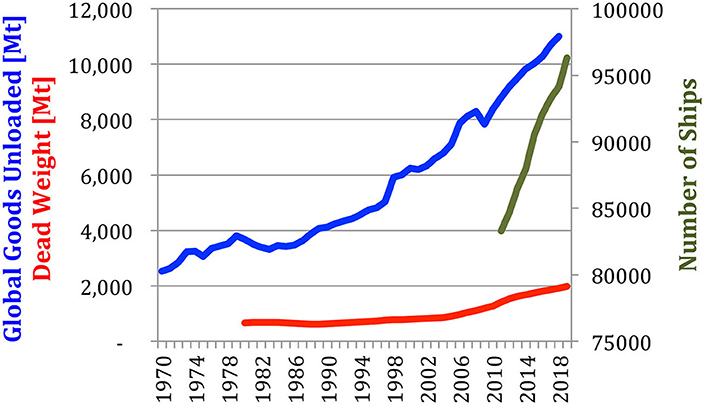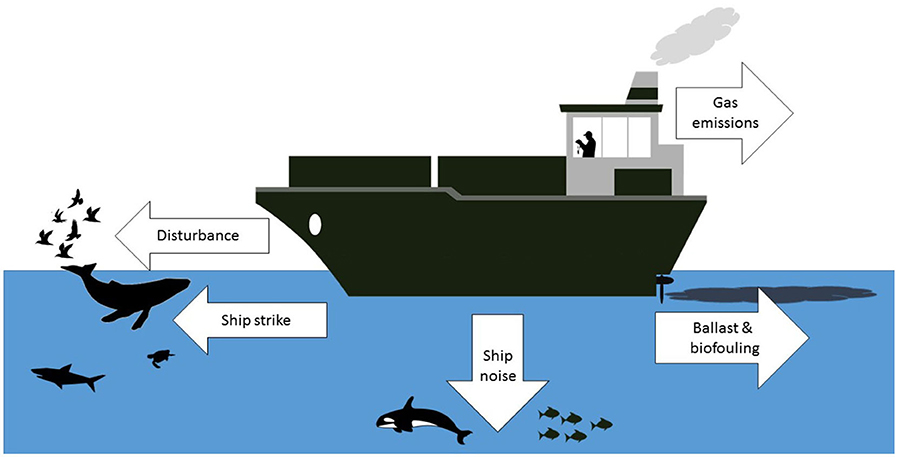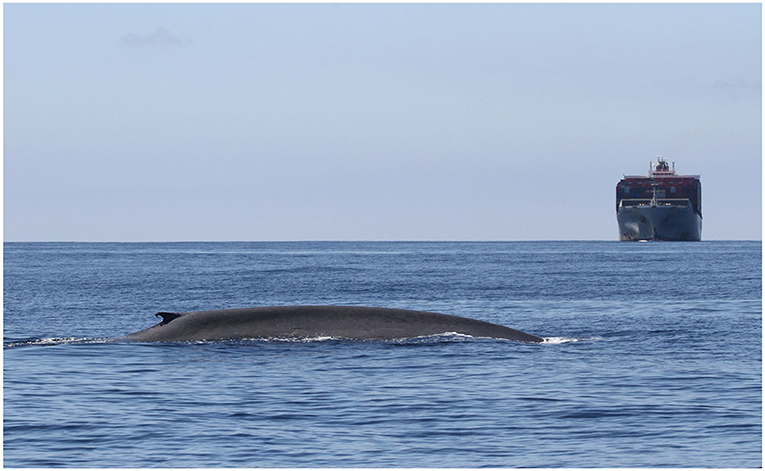- 1Centre for Marine Science and Technology, Curtin University, Perth, WA, Australia
- 2Centre for Sustainable Aquatic Ecosystems, Harry Butler Institute, Murdoch University, Perth, WA, Australia
- 3Anderson Cabot Center for Ocean Life, New England Aquarium, Boston, MA, United States
- 4Data61, CSIRO, Hobart, TAS, Australia
Editorial on the Research Topic
Impacts of Shipping on Marine Fauna
Ship traffic in the ocean keeps increasing
About 80% of international trade goods are transported by ships (UNCTAD, 2019). Over the 49 years from 1970 to 2018, the volume of global seaborne trade increased by a factor 4.41 (Figure 1). The number of ships and the size of ships have also been increasing (Figure 1).

Figure 1. Volume of global goods unloaded from ships (in million tons), dead weight of ships (in million tons), and number of ships1.
At The Same Time, Concern Over Environmental Impacts of Shipping is Increasing
These include chemical pollution of water and air (from fuel spills, waste dumping, and exhaust; Lachmuth et al., 2011; Endres et al., 2018; Arzaghi et al., 2020; Czermański et al., 2020), biofouling on hulls and invasive species (from discharge of ballast water; Jones, 2009), noise pollution in water and air (Wysocki et al., 2006; Badino et al., 2016; Erbe, Marley, et al.), and collision with marine fauna (Jägerbrand et al., 2019; Pirotta et al., 2019; UNCTAD, 2019). Shipping potentially impacts (directly or indirectly) a great range of marine taxa, not just locally but globally.
Research Into the Effects of Ship Traffic and Management of the Associated Risks are Typically Compartmentalized by Type of Impact
Yet the impacts may be cumulative and they may be linked. For example, quieter ships might be harder for animals to detect (i.e., detected over shorter ranges) and thus may represent a higher risk of collision. Faster ships may traverse animal habitat in less time, but at a cost of increased fuel consumption (hence exhaust), higher noise emission levels, and an increased risk of fatal collision. As Leaper highlights, reduced vessel speed could be financially prudent while also reducing greenhouse gas emission, ship noise, and ship strike risk.
There is Potential Benefit From a More Holistic Approach To Studying and Managing The Impacts of Shipping
In this special issue, we've therefore brought together research on the diverse impacts of shipping, on a variety of marine fauna, with examples from the equatorial regions to both poles (Figure 2).1

Figure 2. Infographic on the potential impacts of shipping addressed in this special issue: ship strike (Arregui et al.; Calambokidis et al.; Aschettino et al.; Cloyed et al.; Flynn and Calambokidis; Gende et al.; Greig et al.; Keen et al.; Leaper; Peltier et al.; Redfern et al.; Schoeman et al.; Szesciorka et al.; Silber and Adams; Smith et al.), ship noise (Chion et al.; Erbe, Dähne et al.; Erbe, Marley et al.; Heenehan et al.; Joy et al.; Leaper; Silber and Adams), gas emission (Leaper; Silber and Adams), chemical spill (Silber and Adams), introduced pests (Hayes et al.), and induced flushing (i.e., seabird disturbance, Fliessbach et al.).
Several Articles in This Special Issue Provide an Introduction To and Overview of The Different Types of Impact
Hayes et al. review the risks of biofouling and ballast water discharge and associated management strategies. While their historical overview focuses on Australia and New Zealand, international guidelines and conventions are presented, and the efficacy, practicality and costs of treatment options are discussed. Erbe, Marley, et al. provide an overview of ship noise generation and propagation, and the impacts on marine mammals: change of behavior, auditory masking, and stress. Study challenges, knowledge gaps, and research needs are discussed. Schoeman et al. present a global review of vessel collisions with marine fauna and found that 75 marine species are affected by ship collisions, including whales, dolphins, porpoises, dugongs, manatees, whale sharks, sharks, seals, sea otters, sea turtles, penguins, and fish. Information about collisions with species other than large whales is scarce and Schoeman et al. recommend establishing species-specific necropsy protocols and creating a ship-strike database for smaller species to fill this data gap.
The Behavior of Animals Affects Vulnerability To Potential Impacts
Calambokidis et al. show baleen whales can exhibit differential vulnerability to ship strike based on their movement patterns, swimming, and diving behavior during the day (Figure 3), although diurnal patterns showed a commonality of greater vulnerability at night. The same diurnal risk of collision was found for fin whales by Keen et al. who identify seasonal implications of risk with higher risk during winter where nighttime duration is longer, particularly at high latitudes. Cloyed et al. show that manatees are exposed to interactions with a range of vessels, from large commercial to small recreational vessels, and understanding manateee migration patterns and use of shipping channels is integral to linking and mitigating risk between the offshore and nearshore environment. Similarly, Aschettino et al. document an affinity to high-traffic areas by humpback whales. Despite the overlap of shipping routes with animal habitat and the associated risks of collision and noise exposure, Szesciorka et al. demonstrate for Eastern North Pacific blue whales the importance of the animals' behavioral response in their ability to avoid serious impacts, such as mortality from vessel strike. Fliessbach et al. developed a disturbance vulnerability index (DVI) for 26 seabird species in Northwestern Europe accounting for shyness, escape costs, and compensatory potential. The DVI can be used with distribution data to identify areas vulnerable to disturbance.

Figure 3. Photo of a blue whale in front of a large vessel off California on 4 September 2014. Photo taken by John Calambokidis of Cascadia Research, as part of the diurnal ship strike risk assessment (Calambokidis et al.).
Determining The Risks Posed By Shipping is The First Step in Environmental Impact Assessments
Vessel operations need to be documented and monitored, as Silber and Adams did in the Arctic, which is a marine ecosystem experiencing increased opportunities for maritime activities in historically inaccessible areas. Greig et al. examined some of the issues with speed calculated from Automatic Identification System (AIS) data, which are used in ship-strike risk analysis. While understanding the magnitude of ship strike rates globally is notoriously difficult because they often occur offshore and go unnoticed, Peltier et al. demonstrate the importance of monitoring marine mammal strandings and undertaking necropsies to allow an assessment of the risk of collision. However, when carcasses are in advanced stages of decomposition, it is challenging to distinguish whether trauma occurred ante- or post-mortem. Arregui et al. demonstrate that fat emboli detection can be a feasible, reliable, and accurate forensic tool to determine ante-mortem ship strikes in stranded whales, even in decomposed tissues kept in formaldehyde for long periods of time. Heenehan et al. suggest that soundscape monitoring is useful to assess noise impacts and determine co-occurrence of marine fauna and ships.
The Risks of Collision and Noise Impacts Can Be Mitigated
Redfern et al. explored the consequences of interannual variability on ship-strike risk. They found that areas containing the highest predicted number of whales were generally the same across years. Consequently, either nearshore or offshore ship traffic consistently had the highest risk for each whale species. The consistency in risk suggests that static spatial management measures (e.g., changing shipping lanes, creating areas to be avoided, and seasonal speed reductions) can provide an effective means of mitigating risk in their study area. Smith et al. identified differences in ship strike risk based on the reproductive status of female humpback whales. They found that temporal dynamics in whale movement within a breeding season could affect risk, which can be countered by changes in whale density, and that common mitigation measures (e.g., re-routing shipping lanes) are not always possible. Studies have also assessed the possibility of reducing risk through “active whale avoidance” defined as a mariner making operational decisions to reduce the chance of collision with a sighted whale. Gende et al. generated a conceptual model of active whale avoidance and explored the model using observations of humpback whales surfacing in the proximity of large cruise ships and simulations run in a full-mission bridge simulator and commonly used pilotage software. They identified several options for enhancing whale avoidance and conclude that active whale avoidance is a feasible yet underdeveloped tool for reducing collision. The practicality and effectiveness of placing marine mammal observers on commercial vessels were examined by Flynn and Calambokidis.
Chion et al. compiled a large dataset of published ship noise levels from the literature and demonstrate that reducing speed is a means of achieving lower noise emission levels for any specific ship class and size category. Voluntary commercial vessel slowdown reduced underwater noise and associated “lost foraging time” despite increased transit duration in Joy et al. 's study on endangered southern resident killer whales (Orcinus orca), which used field measurements and modeling.
While this special issue collates articles on various types of shipping impact, on a diversity of taxa, in equatorial to polar regions, commonalities in identified knowledge gaps and research needs have been identified. Risk assessments utilize both ship distribution data (i.e., AIS) and species distribution information. Developments are needed in AIS coverage and accuracy. A better understanding of species distributions is also needed. Uncertainty needs to be considered in risk assessments. This includes uncertainty due to temporal variability (as examined in Redfern et al.), spatial uncertainty (e.g., AIS positional uncertainty), sampling and measurement error, and model uncertainty. Cumulative risk models are needed to assess risk over successive exposures in space and time, and to combine the potentially synergistic impacts of shipping. Understanding how impacts interact and accumulate will improve mitigation solutions by increasing our understanding of when reducing one impact may reduce or increase other impacts.
Managing The Impacts of Shipping Requires Collaboration Amongst Stakeholders and Across Political Borders
The shipping industry, marine scientists, environmental groups, government regulators, socio-economists, etc., need to work together to improve outcomes for all stakeholders and the environment. Political borders never line up with habitats or environmental regions, necessitating collaboration among countries on guidelines and regulations. Examples include the European Marine Strategy Framework Directive (van der Graaf et al., 2012) and the Protocol on Environmental Protection of the Antarctic Treaty, which was the framework for the impact assessment of underwater noise in Antarctica by Erbe, Dähne, et al.. As our understanding of the potential impacts of shipping matures, international standards can ensure consistency in research, mitigation, and management.
At a time when shipping is continuing to increase, we believe the articles in this special issue highlight the important issues facing our global society and serve as a starting point for managing the potential impacts of shipping.
Author Contributions
CE prepared the first draft and created Figure 1. JS created Figure 2. All authors summarized 5, 6 articles each and approved the final version of this Editorial.
Funding
This work was undertaken in part for the Marine Biodiversity Hub, a collaborative partnership supported through funding from the Australian Government's National Environmental Science Programme.
Conflict of Interest
The authors declare that the research was conducted in the absence of any commercial or financial relationships that could be construed as a potential conflict of interest.
Footnotes
1. ^https://unctadstat.unctad.org/EN/BulkDownload.html (accessed June 7, 2020).
References
Arzaghi, E., Sajid, Z., and Abbassi, R. (2020). Advanced methods for environmental risk assessment in offshore operations Methods Chem. Process Saf. 4, 321–354. doi: 10.1016/bs.mcps.2020.04.002
Badino, A., Borelli, D., Gaggero, T., Rizzuto, E., and Schenone, C. (2016). Airborne noise emissions from ships: experimental characterization of the source and propagation over land. Appl. Acoust. 104, 158–171. doi: 10.1016/j.apacoust.2015.11.005
Czermański, E., Pawłowska, B., Oniszczuk-Jastrzabek, A., and Cirella, G. T. (2020). Decarbonization of maritime transport: analysis of external costs. Front. Energy Res. 8:28. doi: 10.3389/fenrg.2020.00028
Endres, S., Maes, F., Hopkins, F., Houghton, K., Mårtensson, E. M., Oeffner, J., et al. (2018). A new perspective at the ship-air-sea-interface: the environmental impacts of exhaust gas scrubber discharge. [Review]. Front. Mar. Sci. 5:139. doi: 10.3389/fmars.2018.00139
Jägerbrand, A. K., Brutemark, A., Barthel Svedén, J., and Gren, I.-M. (2019). A review on the environmental impacts of shipping on aquatic and nearshore ecosystems. Sci. Tot. Environ. 695:133637. doi: 10.1016/j.scitotenv.2019.133637
Jones, G. (2009). “Chapter 2: The battle against marine biofouling: a historical review,” in Advances in Marine Antifouling Coatings and Technologies, eds C. Hellio and D. Yebra (Cambridge, MA: Woodhead Publishing), 19–45. doi: 10.1533/9781845696313.1.19
Lachmuth, C. L., Barrett-Lennard, L. G., Steyn, D. Q., and Milsom, W. K. (2011). Estimation of southern resident killer whale exposure to exhaust emissions from whale-watching vessels and potential adverse health effects and toxicity thresholds. Mar. Pollut. Bull. 62, 792–805. doi: 10.1016/j.marpolbul.2011.01.002
Pirotta, V., Grech, A., Jonsen, I. D., Laurance, W. F., and Harcourt, R. G. (2019). Consequences of global shipping traffic for marine giants. Front. Ecol. Environ. 17, 39–47. doi: 10.1002/fee.1987
UNCTAD (2019). Review of Maritime Transport. Geneva: United Nations Conference on Trade and Development.
van der Graaf, A. J., Ainslie, M. A., Andre, M., Brensing, K., Dalen, J., Dekeling, R. P. A., et al. (2012). European Marine Strategy Framework Directive–Good Environmental Status (MSFD GES): Report of the Technical Subgroup on Underwater Noise and Other Forms of Energy (JRC Scientific and Technical Report). Brussels: TSG Noise & Milieu Ltd.
Keywords: ship noise, ship strike risk, collision, marine mammal, biofouling, oil spill, shipping impact
Citation: Erbe C, Smith JN, Redfern JV and Peel D (2020) Editorial: Impacts of Shipping on Marine Fauna. Front. Mar. Sci. 7:637. doi: 10.3389/fmars.2020.00637
Received: 07 July 2020; Accepted: 13 July 2020;
Published: 21 August 2020.
Edited and reviewed by: Laura Airoldi, University of Padova Chioggia Hydrobiological Station, Italy
Copyright © 2020 Erbe, Smith, Redfern and Peel. This is an open-access article distributed under the terms of the Creative Commons Attribution License (CC BY). The use, distribution or reproduction in other forums is permitted, provided the original author(s) and the copyright owner(s) are credited and that the original publication in this journal is cited, in accordance with accepted academic practice. No use, distribution or reproduction is permitted which does not comply with these terms.
*Correspondence: Christine Erbe, Yy5lcmJlQGN1cnRpbi5lZHUuYXU=
 Christine Erbe
Christine Erbe Joshua Nathan Smith
Joshua Nathan Smith Jessica V. Redfern
Jessica V. Redfern David Peel
David Peel